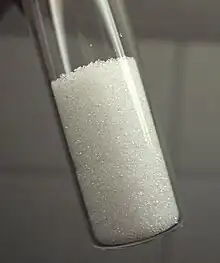Beryllium sulfate
Beryllium sulfate normally encountered as the tetrahydrate, [Be(H2O)4]SO4 is a white crystalline solid. It was first isolated in 1815 by Jons Jakob Berzelius.[4] Beryllium sulfate may be prepared by treating an aqueous solution of many beryllium salts with sulfuric acid, followed by evaporation of the solution and crystallization. The hydrated product may be converted to anhydrous salt by heating at 400 °C.[5]
 | |
 | |
| Identifiers | |
|---|---|
| |
3D model (JSmol) |
|
| ChEBI | |
| ChemSpider | |
| ECHA InfoCard | 100.033.478 |
| EC Number |
|
PubChem CID |
|
| RTECS number |
|
| UNII |
|
CompTox Dashboard (EPA) |
|
| |
| |
| Properties[1] | |
| BeSO4 | |
| Molar mass | 105.075 g/mol (anhydrous) 177.136 g/mol (tetrahydrate) |
| Appearance | white solid |
| Odor | odorless |
| Density | 2.44 g/cm3 (anhydrous) 1.71 g/cm3 (tetrahydrate) |
| Melting point | 110 °C (230 °F; 383 K) (tetrahydrate, −2H2O) 400 °C (dihydrate, dehydr.) 550–600 decomposes |
| Boiling point | 2,500 °C (4,530 °F; 2,770 K) (anhydrate) 580 °C (tetrahydrate) |
| 36.2 g/100 mL (0 °C) 40.0 g/100 mL (20 °C) 54.3 g/100 mL (60 °C) | |
| Solubility | insoluble in alcohol |
Refractive index (nD) |
1.4374 (tetrahydrate) |
| Thermochemistry | |
Std molar entropy (S⦵298) |
90 J/mol K |
Std enthalpy of formation (ΔfH⦵298) |
-1197 kJ/mol |
Gibbs free energy (ΔfG⦵) |
-1088 kJ/mol |
| Hazards | |
| GHS labelling: | |
   | |
| Danger | |
| H301, H315, H317, H319, H330, H335, H350, H372, H411 | |
| Flash point | Non-flammable |
| Lethal dose or concentration (LD, LC): | |
LD50 (median dose) |
82 mg/kg (rat, oral) 80 mg/kg (mouse, oral)[2] |
| NIOSH (US health exposure limits): | |
PEL (Permissible) |
TWA 0.002 mg/m3 C 0.005 mg/m3 (30 minutes), with a maximum peak of 0.025 mg/m3 (as Be)[3] |
REL (Recommended) |
Ca C 0.0005 mg/m3 (as Be)[3] |
IDLH (Immediate danger) |
Ca [4 mg/m3 (as Be)][3] |
| Safety data sheet (SDS) | ICSC 1351 |
| Related compounds | |
Other cations |
Magnesium sulfate Calcium sulfate Strontium sulfate Barium sulfate |
Except where otherwise noted, data are given for materials in their standard state (at 25 °C [77 °F], 100 kPa).
Infobox references | |
Structure
According to X-ray crystallography the tetrahydrate contains a tetrahedral Be(OH2)42+ unit and sulfate anions. The small size of the Be2+ cation determines the number of water molecules that can be coordinated.[6] In contrast, the analogous magnesium salt, MgSO4·6H2O contains an octahedral Mg(OH2)62+ unit.[7] The existence of the tetrahedral [Be(OH2)4]2+ ion in aqueous solutions of beryllium nitrate and beryllium chloride has been confirmed by vibrational spectroscopy, as indicated by the totally symmetric BeO4 mode attt 531 cm−1. This band is absent in beryllium sulfate, and the sulfate modes are perturbed. The data support the existence of Be(OH2)3OSO3.[8]
The anhydrous compound has a structure similar to that of berlinite. The structure contains alternating tetrahedrally coordinated Be and S and each oxygen is 2 coordinate (Be-O-S). The Be-O distance is 156 pm and the S-O distance is 150 pm.[9]
A mixture of beryllium and radium sulfate was used as the neutron source in the discovery of nuclear fission.
References
- Weast, Robert C., ed. (1981). CRC Handbook of Chemistry and Physics (62nd ed.). Boca Raton, FL: CRC Press. p. B-82. ISBN 0-8493-0462-8..
- "Beryllium compounds (as Be)". Immediately Dangerous to Life or Health Concentrations (IDLH). National Institute for Occupational Safety and Health (NIOSH).
- NIOSH Pocket Guide to Chemical Hazards. "#0054". National Institute for Occupational Safety and Health (NIOSH).
- Lathrop Parsons, Charles (1909), The Chemistry and Literature of Beryllium, London, pp. 29–33, ISBN 9780559264160
{{citation}}: CS1 maint: location missing publisher (link). - Patnaik, Pradyot (2002), Handbook of Inorganic Chemicals, McGraw-Hill, ISBN 0-07-049439-8.
- Kellersohn, T.; Delaplane, R. G.; Olovsson, I. (1994). "The synergetic effect in beryllium sulfate tetrahydrate – an experimental electron-density study". Acta Crystallographica Section B: Structural Science. 50 (3): 316–326. doi:10.1107/S010876819400039X.
- Wells A.F. (1984) Structural Inorganic Chemistry 5th edition Oxford Science Publications ISBN 0-19-855370-6
- Rudolph, Wolfram W.; Fischer, Dieter; Irmer, Gert; Pye, Cory C. (2009). "Hydration of Beryllium(II) in Aqueous Solutions of Common Inorganic Salts. A Combined Vibrational Spectroscopic and ab initio Molecular Orbital Study". Dalton Transactions (33): 6513–6527. doi:10.1039/B902481F. PMID 19672497.
- Grund, Alfred (1955). "Die Kristallstruktur von BeSO4". Tschermaks Mineralogische und Petrographische Mitteilungen. 5 (3): 227–230. Bibcode:1955MinPe...5..227G. doi:10.1007/BF01191066. ISSN 0041-3763.